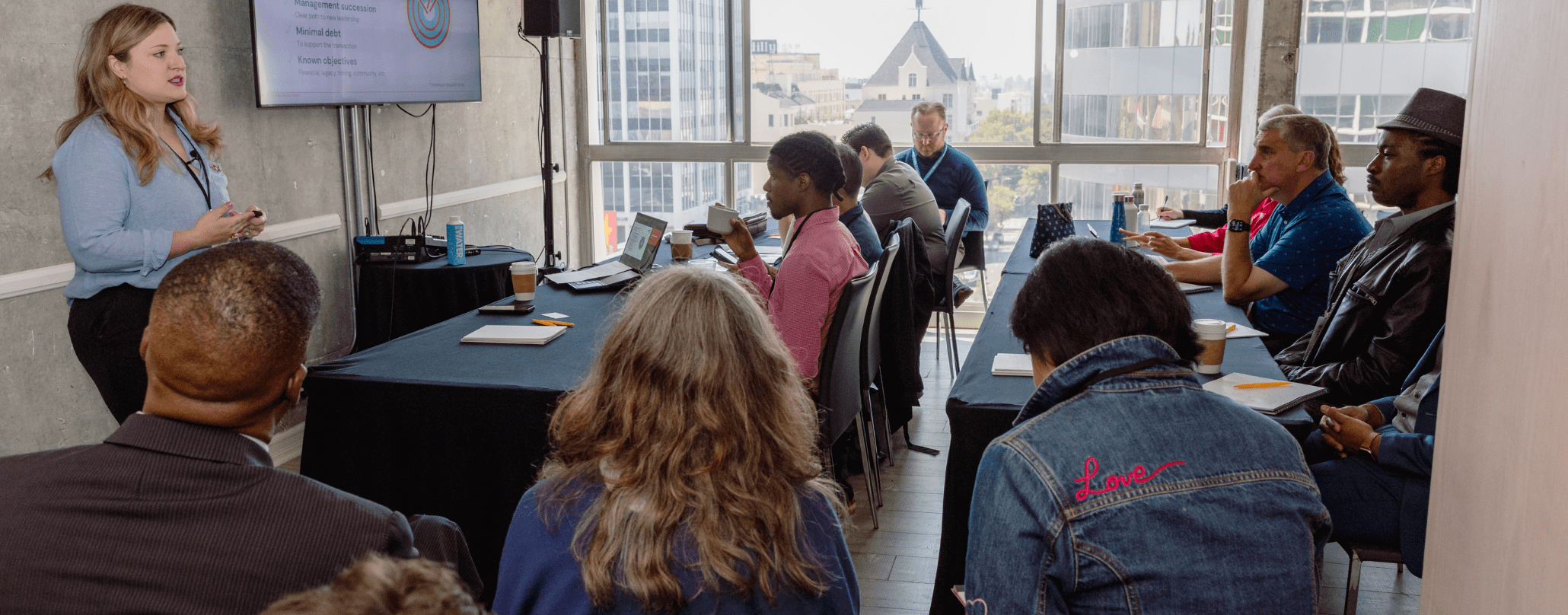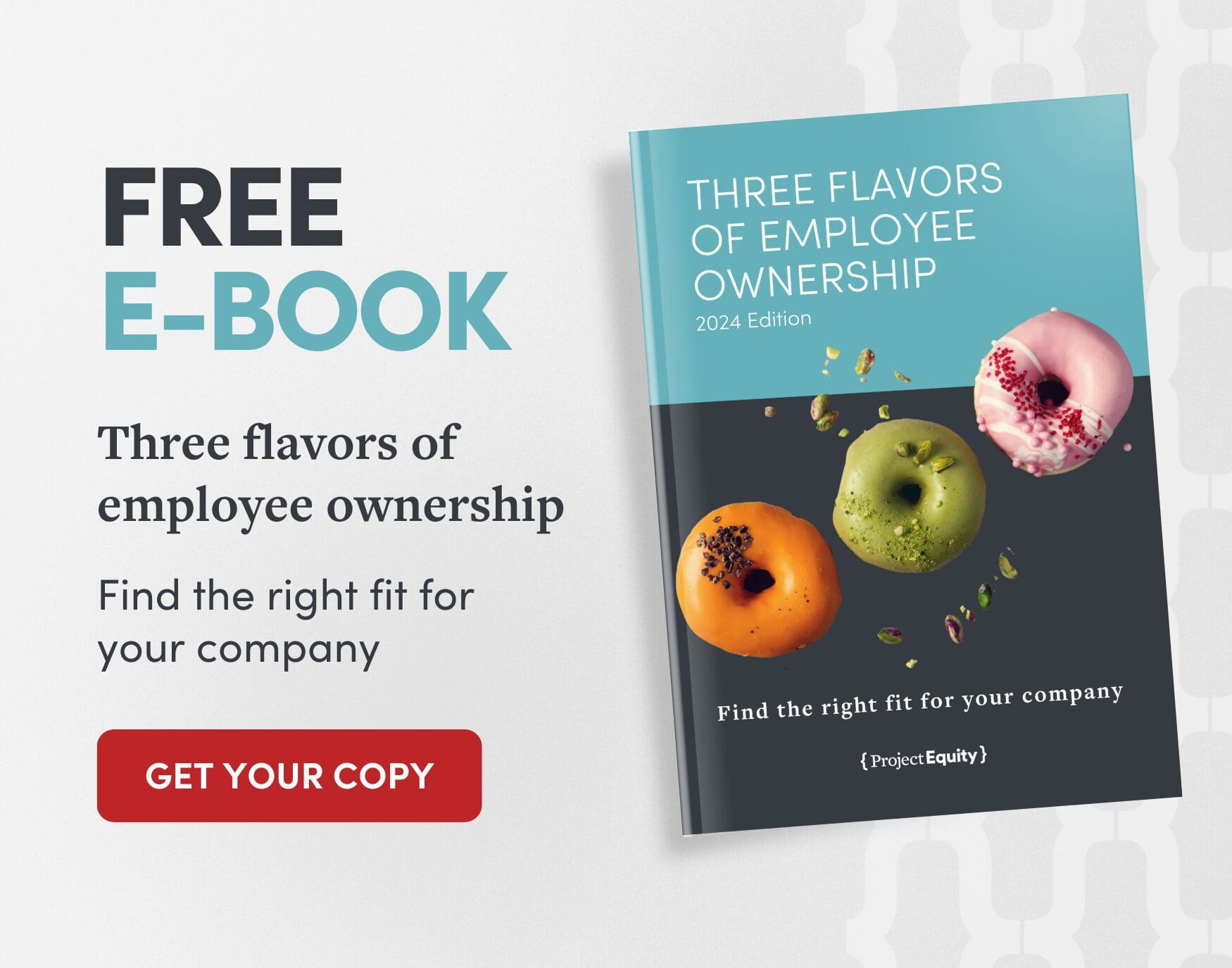How employee ownership helps small and mid-sized businesses: what advisors need to know
- Project Equity
Small and mid-sized businesses fuel the U.S. economy, but today, many face challenges including economic uncertainty, talent retention and succession planning.
Business advisors who work with owners of companies like these are viewed as crucial experts for business operations and growth. As a business advisor, the more solutions to these business challenges you have at your disposal, the happier you and your clients will be.
Many business advisors are becoming experts in employee ownership (EO) as a suite of strategic solutions for their clients. In this post, we’ll explore what EO is and its various benefits—specifically honing in on how this business model helps small and medium-sized businesses—so you can walk away with key knowledge for advising your clients and a competitive advantage in the marketplace.
What is EO?
You may be familiar with Employee Stock Ownership Plans, also known as ESOPs, but EO is more than that. EO encompasses worker cooperatives, Employee Ownership Trusts (EOTs) and other models where employees hold a portion of the company’s shares or equity, giving them a stake in the company’s success and potentially its profits.
Here is a brief overview of the three main types of EO in the U.S.:
- ESOPs, the most common type, which, like 401(k)s, are qualified retirement plans where all or part of a company’s shares are administered by a trust on behalf of the workers.
- Worker cooperatives, known as coops, are companies owned and controlled by—and for the benefit of—the people who work there.
- EOTs are trusts that hold some or all of the shares of companies on behalf of the employees.
And, EO isn’t just an exit strategy. Some EO models are quite flexible; business owners can name the terms that fit their goals—a full or partial sale of the company’s shares and everything from immediate retirement to staying on in a leadership role to a gradual hand-over—making it a great option for owners of all ages.
Now, let’s explore some benefits of EO for small and mid-sized businesses.
EO as a risk mitigation strategy
Financial stability and resilience
Companies with EO structures are generally more resilient during economic downturns and other periods of turmoil and have higher survival rates. A 2023 NCEO and ESCA study found that nearly 80% of S ESOP leaders believed EO helped them manage economic disruptions. For the podcasting company Maximum Fun, converting to a worker cooperative helped them retain resilience in a turbulent industry.
Other studies have shown that employee-owned companies fared better during the COVID-19 pandemic and the 2008 financial crisis. This financial stability can be particularly valuable for small and mid-sized businesses, which are often more vulnerable to economic shifts than larger corporations.
Lower turnover and higher retention
Businesses with broad-based EO often enjoy higher retention rates. In one study, ESOP companies were much less likely to see retaining key employees as a major challenge compared to non-ESOPs (6% versus 22%). In another study, less than ½% of employee-owners were laid off in the last year versus 7.5% of non-owners.
In our own work, we connected with Happy Earth Cleaning Co-op, a business we helped transition into a worker cooperative, and found that their annual staff turnover decreased significantly as a result of EO.
Reduced turnover results in lower hiring and training costs, while retaining experienced employees helps maintain institutional knowledge and operational efficiency.
Talent attraction and workforce stability
Competitive compensation without additional cash costs
With company growth, workers in employee-owned businesses can accumulate retirement benefits and financial rewards. Workers can earn equity beyond just typical 401(k)s. Employees build wealth over time as the business grows, providing them with significant savings that they wouldn’t typically have in non-EO companies.
Even in lower-paying industries, workers in employee-owned companies tend to have more asset-building opportunities than in non-employee-owned companies. Of the eight businesses we surveyed in 2024, the employees were earning 20% more on average than they did before the companies became employee-owned.
This financial security and unique incentive makes employee-owned businesses stand out in a competitive job market where talent shortages are reportedly one of the biggest challenges for small and mid-sized businesses. It also incentivizes employees to stay longer, ensuring a stable workforce.
Improved job satisfaction and productivity
Employee-owned companies often benefit from higher productivity and engagement. The 2018 Employee Ownership Foundation survey indicated that over 67% of respondents believed implementation of the ESOP increased the company’s overall productivity. Another study found that productivity improves by an extra 4-5% on average in the year an ESOP is adopted, and the higher productivity level is maintained in subsequent years.
When employees have a stake in the company’s success, they tend to be more motivated, committed and proactive in their roles. Cooperation among employees is also higher, and they have higher job satisfaction.
As a worker-owner from Maximum Fun shared:

This heightened engagement can translate into improved performance, innovation and profitability—factors that are crucial for businesses aiming for growth or navigating challenging markets.
Succession planning and business continuity
The Silver Tsunami opportunity
2.9 million businesses in the U.S. have owners aged 55+. The coming Silver Tsunami of retiring business owners presents a tremendous opportunity for business advisors who understand EO. Transitioning to EO provides retiring business owners a sustainable succession plan, while keeping jobs and wealth in local communities.
Younger generations are exiting
This isn’t just limited to owners aged 55+, however. A 2023 Exit Planning Institute National State of Owner Readiness survey found that younger owners are embracing exit planning: 21% of millennials and 20% of Generation Z owners surveyed reported exploring exit strategies. Similar to older business owners, these younger generations can exit their businesses and keep their businesses in the area.
Stronger business continuity
Companies that transition to EO experience fewer disruptions compared to third-party sales or closures. Some businesses struggle to find buyers, leaving owners with limited exit options. Family members—especially those in the second generation of a family-owned business—are less likely to want to inherit family businesses than in the past. And when outside companies such as private equity firms buy businesses, you can’t ensure that the business will stay the same.
Growth and competitiveness through EO
Innovation and decision-making
In one study, 83% of employee-owned businesses reported increased employee motivation since adopting an EO model, and 73% reported increased job satisfaction. Additionally, EO can enhance workplace culture. A more inclusive ownership structure fosters transparency, communication and collaboration and builds a strong, loyal workforce.
“I love being a part owner of the business at which I work. I’ve found it very empowering,” an employee-owner from Happy Earth shared. “Overall, Happy Earth is the most respective place I’ve worked. I feel valued and trusted there.”
Prairie’s 2024 Construction Survey found that ESOPs excel at navigating challenges. Over 90% of contractors reported that EO positively impacted company culture. Employees became more engaged, aligned with company values, developed cost-saving processes, prioritized safety, and took proactive steps to protect and grow their future.
Moreover, employee-owned businesses are more likely to offer training opportunities to their workers. In a Rutgers study, 70% of ESOP workers had training versus 47% of non-ESOP workers. In communicating with four small businesses we helped transition to EO, we learned that many had instituted on-the-job training since the transition.
Workers in cooperatives and EOTs can also participate more readily in running businesses, giving them more ownership and opportunities to flourish and grow beyond the scope of their roles.
With these factors in mind, EO increases innovation, problem solving and decision-making on the job, giving businesses a strategic advantage over their competitors.
Customer and community trust
EO is highly favored across the political spectrum. According to a recent survey, 91% of respondents support broad-based EO.
of respondents support broad-based EO
The 2025 Edelman Trust Barometer also demonstrated that people view businesses that provide good-paying jobs, train or reskill employees, and address affordability as more competent and ethical than other businesses. Employee-owned businesses have been proven to do all of the above.
It isn’t surprising that consumers and businesses would look positively upon employee-owned companies and be more likely to buy products or services from them.
Why business advisors need to understand EO
As EO emerges as a powerful strategy for business owners, it’s important for business advisors to gain knowledge about it.
- EO helps reduce risks, retain talent and improve financial outcomes for small and mid-sized businesses.
- EO expands advisory offerings and enhances credibility with succession-planning clients.
- Many EO businesses qualify for tax incentives (e.g., S Corp tax avoidance for ESOPs, tax deductions for patronage for coops and tax deductions for profit-sharing to EOTs), making them attractive financial options.
- Employee-owned businesses can sell at market value—which isn’t guaranteed if owners sell to family or the business is acquired by an outside buyer.
EO: a key strategy for business success
EO isn’t just an exit strategy—it’s a powerful, multifaceted solution for small and mid-sized businesses facing economic uncertainty, talent retention issues and succession challenges. By fostering financial resilience, enhancing workforce stability and strengthening business continuity, EO provides a competitive edge that benefits both business owners and employees alike.
For business advisors, understanding EO isn’t just an added skill—it’s a crucial differentiator. Advisors who incorporate EO into their practice can provide clients with innovative solutions that drive long-term success. By deepening your expertise in EO, you’ll be better positioned to guide business owners toward sustainable and profitable transitions.
Want to learn more about EO and become a certified expert? Project Equity offers many different accredited training opportunities to fit your needs. Built specifically for exit planners, CPAs, CFPs, wealth planners, attorneys and other advisors, our EO Advantage learning products will equip you with the knowledge and tools to effectively guide your clients through the complexities of EO transitions. Find out how to enhance your service line, better serve your clients and stand out in the marketplace.



